|

                            
Wearing its many scars
exceedingly well, but on its sleeve...
|
|
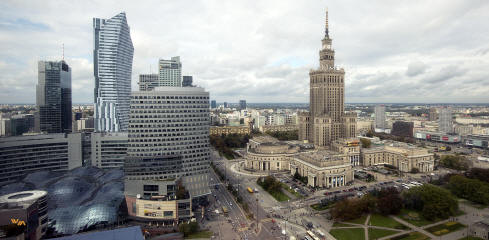
Warsaw Marriott room with a view - new and old
architecture contrast |
If there's such a place as a second world country,
Poland is that. Located right in the crossroads of Europe
and therefore devastated in two world wars, it was then
occupied by the Soviets for the next 40+ years. Today as
a part of the EU but not on the Euro, Poland has risen
from its own ashes, yet the many signs of remembrance
are everywhere. Armed with few preconceptions, I enjoyed
everything about Poland. It was generally inexpensive.
It feels safe, even in areas that look run down and
nearly every Pole that I encountered spoke English.
There was an order to their society that made things
work well. For example, pedestrian laws were followed
and there were far fewer homeless or mentally ill people
on the streets than in the US.
|
|
|
Wednesday, September 25th - Krakow's Market Square
I arrived in Krakow around 2pm
after connecting through Frankfurt. I was met by my excellent
driver, Taxi George (+48 602 632 093, transkor@op.pl), and
headed to the
Qubus Hotel (first picture below) just across the Vistula
river from the
Kazimierz district, a few blocks from
Schindler's Factory and less than a mile from the main
market square. After a quick turnaround, I walked north
through Kazimierz to Krakow's huge Market Square (second
and third pictures below) which bustled with people and crowded
outdoor cafes. After dinner at the Hard Rock Cafe overlooking
the square, I walked all through the old town area before
taking the tram back to my hotel and retiring for the night.
The tram stop was at the
Ghetto Heroes Square (fourth picture below).
|
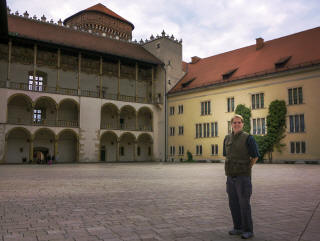
Krakow's Wawel Castle inner courtyard |
|
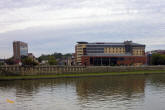
Qubus Hotel on the Vistula |
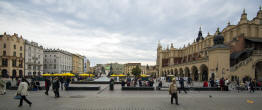
Krakow's Market Square, south side |
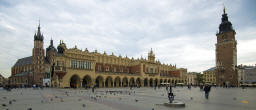
Krakow's Market
Square, north side |
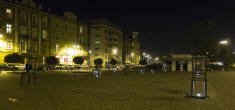
Ghetto Heroes Square's empty chairs |
|
Thursday, September 26th - Wieliczka salt mine &
Schindler's Factory
After figuring out Krakow's tram and bus system, I decided to
follow the advice of my clients in Krakow and spend half of my first
free day 10 miles out of town at the
Wieliczka salt mine. I wondered why a salt mine was such a
big deal until I visited this one. Almost a thousand years old
with over 180 miles of tunnels and 2000 chambers, the sheer
magnitude of the place was impressive. Salt was the best way
to preserve food through most of the last millennium and as
such, it made the city of Wieliczka and its miners very rich.
Everything - floors, walls and ceilings is made of salt. Most
interesting though is the artwork made of salt, which ranged
from simple statues (first picture below) to elaborate
chambers (second picture below) to entire rooms (third and
fourth pictures below).
|
|
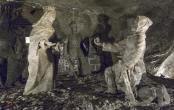
Wieliczka salt mine statues |
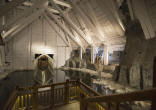
Wieliczka salt mine
chamber |
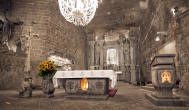
Wieliczka salt mine alter |
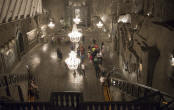
Wieliczka St. Kinga Chapel |
|
The Tourist
Route tour in English, which covers less than 1% of the mine,
has over 800 steps down, 400 to the first level (example first
picture below) and lasts three hours. An elevator whisks you
back up. Taking pictures in the mine exercised much of what I
learned in my photography classes. Salt crystals, even if they
appear dark, reflect light in a way no camera working in
automatic or program mode properly exposes to - and forget
about using a flash without it blasting most of its light back
at you. The four pictures above were all taken in manual mode
using my 16-35mm f4 lens.
Returning to my hotel in the late afternoon, I walked the few
blocks to
Schindler's Factory, which is now a museum focusing on the
Jewish ghetto of Krakow during Nazi occupation. The film at
the beginning was okay, but too long in the interviews, and
much of the exhibition retraced well worn history, but I found
the Schindler factory elements of it most interesting (second
picture below). I finished the day in Kazimierz on "restaurant
row" (third picture below) with an excellent Polish dinner at
Szara. Friday was a work day at my client's site, but after work I took the
tram to Market Square and grabbed some night shots in the old
town (fourth picture below) before packing for my weekend
excursion to Warsaw and retiring for the night.
|
|
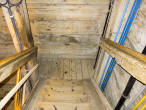
Wieliczka salt mine steps |
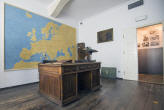
Oskar Schindler's office |
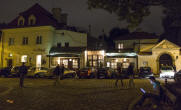
Kazimierz restaurant row at night |
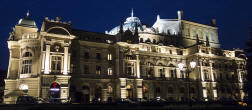
Krakow's Slowacki Theatre at night |
|
Saturday & Sunday, September 28th & 29th - Warsaw, the
Royal Walk
After a quick tram ride from my hotel to Krakow's main rail
station, I boarded express train 3110 to Warsaw at 10am. I was
quickly reminded of how well the train system in Europe works,
even in its less developed countries. By 1pm I was in Warsaw
and checked into a corner suite with a great view (large
picture top of page left) at the
Warsaw Marriott. Unlike Krakow, which was spared most of
the physical destruction of World War 2, Warsaw was
essentially leveled by 1945, leaving today's contrasts in Warsaw's
architecture to run the gamut of Soviet era ugliness, old town
"recreated" and new age modern.
Armed with
Rick Steves' Krakow, Warsaw & Gdansk snapshot guide,
I walked east on Al. Jerozolimskie, then connected to the Royal
Way north on Nowy Swat. Near Warsaw University the street name
changes to Krakowski Przedmiescie and a large statue of
Polish native Copernicus sits in front of the
Copernicus Science Center (first picture below). Directly across the
street is the Church of the Holy Cross, where Warsaw native Frederick
Chopin's heart is entombed in one of the pillars (second
picture below). The rest of his body is at Père Lachaise
Cemetery in Paris, where he spent most of his productive
years. After a late lunch at the
BrowArmia brewpub, I continued north past
Radziwill Palace
(third picture below), where the Warsaw Pact was signed in
1955 uniting the Soviet block. After a side walk through Saxon
Garden, I continued into the huge old town square which was
filled with people, cafes and wedding parties. I then explored
the side streets, in the shadow of the Royal Palace (fourth
picture below) before heading back to my hotel. It turned out
to be at least 10 miles of walking that day, so half-way back
I rewarded myself at
A. Blikle
Pastries with their famous paczki, which is a donut filled
with rose flavored jelly. I finished the day at the Marriott's
concierge lounge. After five days of jet lag and full
schedules, I decided to sleep in Sunday morning before a short
walk through the Soviet era Culture Palace grounds and a great
Polish lunch at
Restaurant Zgoda. I caught my train at 3:45pm, arriving
back in Krakow around 7pm. Monday was a work day on-site with
my clients followed by a work dinner.
|
|
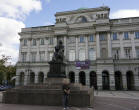
Warsaw Copernicus Statue |
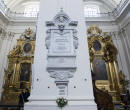
Warsaw Chopin's heart |
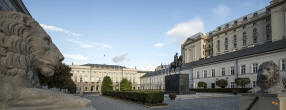
Warsaw Pact site - Radziwill's Palace |
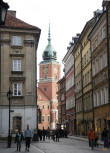
Warsaw old town |
|
Tuesday, October 1st - Auschwitz & Wawel Castle
On my last free day in Poland I decided to visit
Auschwitz,
which is located in Oswiecim, about 90 minutes outside of
Krakow. I think it's a legitimate question to ask, why visit a
horrible place like this on a vacation? For myself, with no
Polish or Jewish heritage, it's the history and the impact
that only "being there" can have. I could have read everything
about Auschwitz and never gotten anywhere near the sense of
the place that I got first-person. I have had four prior
experiences visiting concentration camps -
Sachsenhausen near Berlin twice, once with Ben and once
with Craig,
Mauthausen in Austria and
Dachau near Munich. But Auschwitz was different. Besides
being massive in size - 60 square miles in total, its purpose
was not to house prisoners. Instead its main purpose was to
exterminate them. Most people sent to the camp lived less than
four hours after they arrived. It's hard to comprehend without
seeing the huge gas chambers and crematoriums that over a
million people were killed at Auschwitz in just over three
years.
Auschwitz is actually three camps, the smaller base camp built
from existing buildings, the much larger extermination camp
called Birkenau and a labor camp, Monowitz. Much of the
required guided tour takes place at the base camp, starting
with the "Arbeit Macht Frei" (work sets you free) gate (first
picture below) that is at every concentration camp. A bus
takes the group over to Birkenau, about ten minutes away. The
second picture below shows the view from the top of the iconic
Birkenau guard tower with the rail line passing underneath it.
Prisoners arrived in packed rail cars (third picture below)
where they were "sorted" for immediate extermination in the
gas chambers or for work. At the end of the rail line inside
the camp a simple memorial is set up (fourth picture below).
The guided tour was powerful and excellent, moving along at a
fast clip throughout its three-plus hours. For me, Auschwitz
is a solemn reminder, to paraphrase Lord Acton's famous quote
from 1887, that a government - any government - given absolute
power over its people will corrupt that power absolutely.
|
|
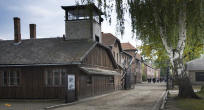
Auschwitz Arbeit Macht Frei gate |
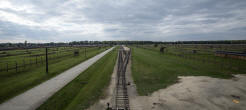
Auschwitz wide view from the tower |
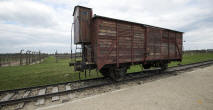
Auschwitz prisoner rail car |
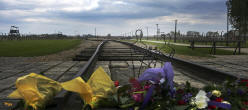
Auschwitz end of the rail memorial |
|
Returning to Krakow mid-afternoon, I did a
quick turnaround at the hotel and then took its free boat taxi
to
Wawel Castle. It was a cold, overcast day without any
other passengers or much river traffic, so the captain gave me
the wheel for most of the trip (first picture below).
Approaching from the river gave me a good wide shot of the
castle and its walls (second picture below). Arriving at the
dock without causing any major international maritime
incidents, I walked around the north wall past the
fire-breathing dragon (third picture below), which is the
symbol of the Castle, to the entrance. The grounds of the
castle are beautiful and the views from its hilltop over
Krakow were wonderful. The inner courtyard (large picture top
of page right) has the entrances to its many museum rooms, all
of which were closed or closing when I arrived in the early
evening. After walking the grounds and the rooms that were
open, I took the short walk into Krakow's Market Square where
I had a remarkable last dinner in Poland at
Vintage, a wine bar and cafe right on the square. Armed
with only my small tripod, I used my point and shoot camera to
take a night shot of myself in the square - fourth picture
below. The next day I returned home to LA via Frankfurt and
Houston. All-in-all a good business, extended into
sightseeing, journey through Poland. |
|
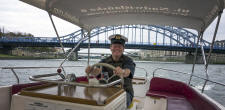
Vistula River -
Wayne at the wheel |
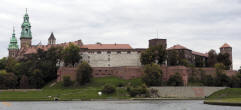
Wawel Castle from
the Vistula River |
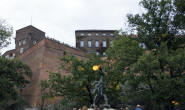
Wawel Castle's
dragon |
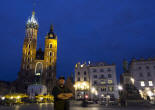
Krakow Market
Square night |

                            
Mackey Group, Inc.
© 2002 - 2014
|
|